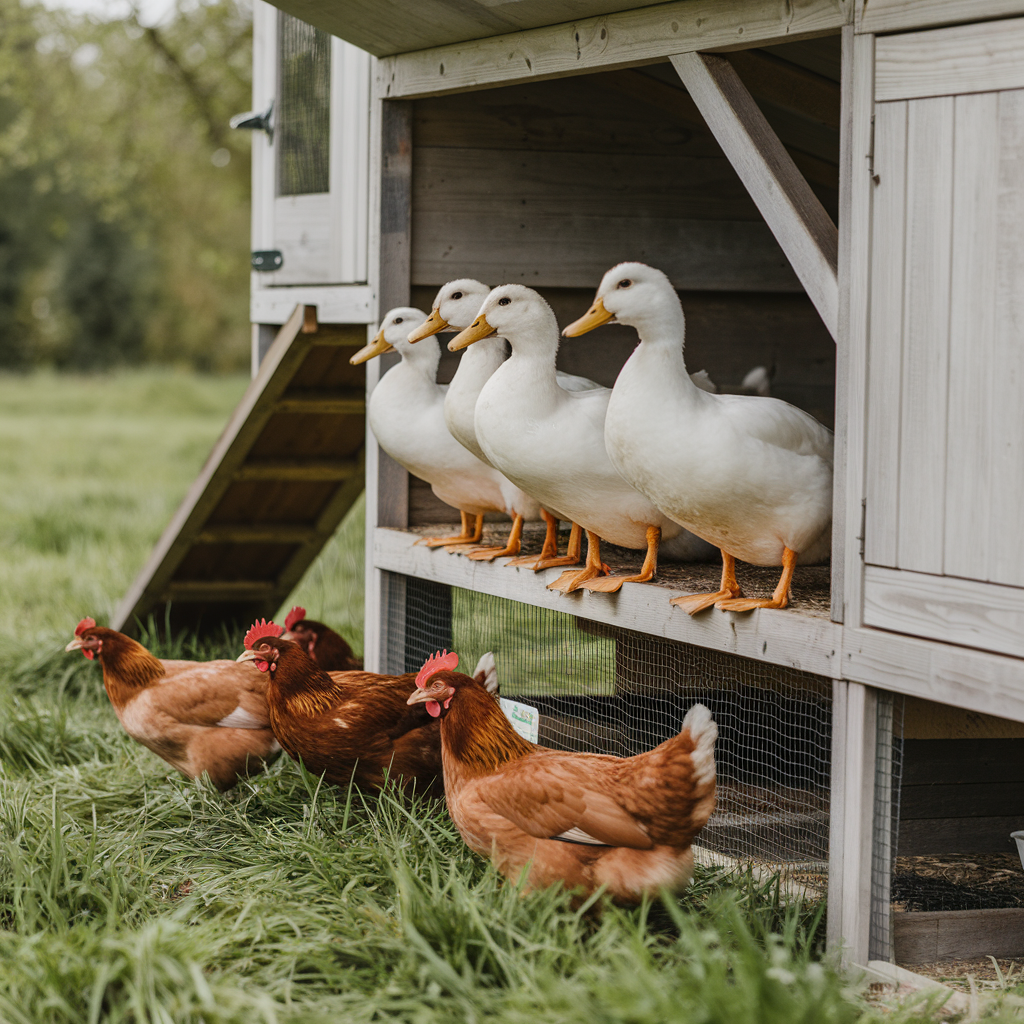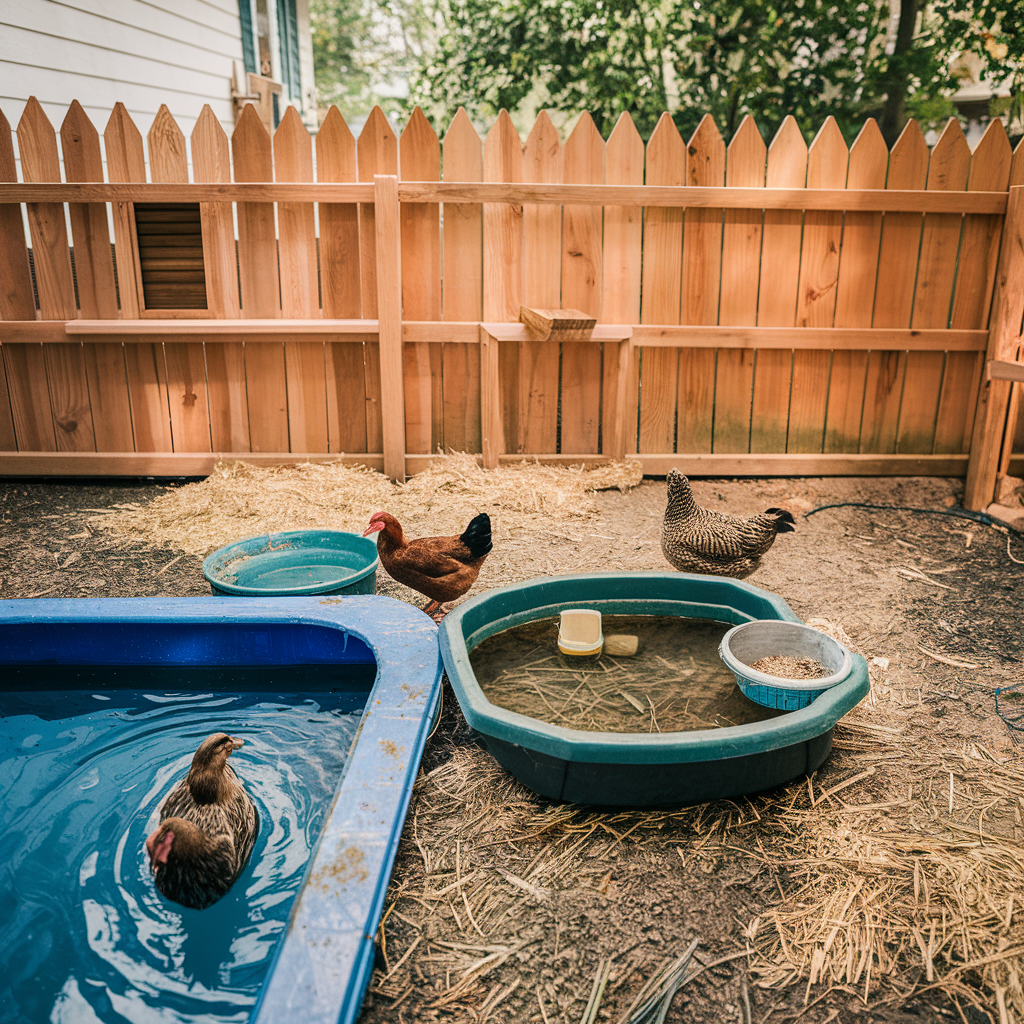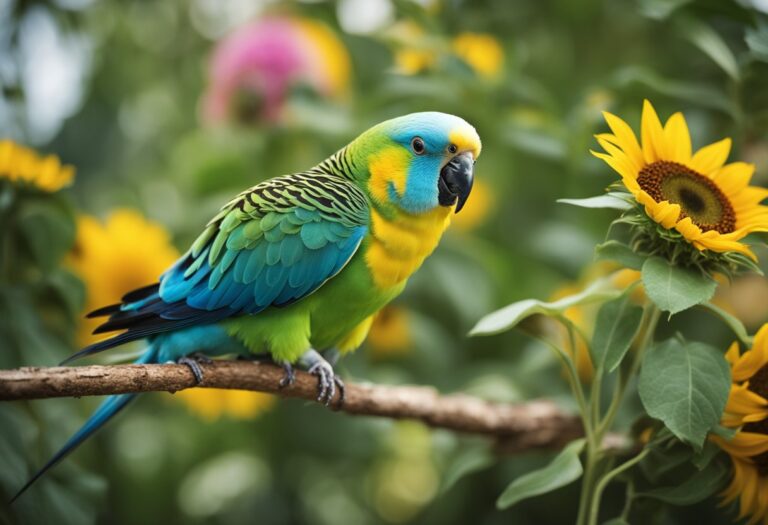Many People with backyard space who interested birds always ask this question, can ducks and chickens live together? Yes, ducks and chickens can share living quarters, but keep in mind. Ducks and chickens can peacefully cohabitate as long as you address their different needs for housing, feeding, and general care.

When I first combined my flock, I noticed that while chickens and ducks get along well, they have distinct requirements. Ducks need water for swimming and cleaning their bills, while chickens prefer dry conditions. Their different sleeping habits—chickens roost while ducks sleep on the ground—also need accommodation in a shared coop environment.
Key Takeaways
- Ducks and chickens can share space successfully with proper housing modifications that address their different sleeping and water needs.
- Each species requires specific nutritional considerations, with ducks needing more niacin and chickens requiring different protein levels.
- Health monitoring is essential as these birds can transmit diseases to each other, requiring regular cleaning and occasional separate spaces.
Housing Considerations for Co-Habitating Species
When keeping ducks and chickens together, proper housing design makes all the difference for harmonious living. The right setup addresses the different needs of both species while maintaining safety and comfort.
Designing a Shared Coop
A well-designed shared coop needs to accommodate the natural behaviors of both birds. Chickens prefer to roost at night, so I recommend installing roosting bars at various heights. Ducks, however, sleep on the ground and don’t use roosting bars.
The coop entrance should be wide enough for ducks, which waddle rather than hop. I suggest a minimum door width of 12 inches and a ramp with good traction for easy access.
Space is crucial for peaceful coexistence. I’ve found that providing plenty of room prevents territorial disputes. Allow at least 4 square feet per bird inside the coop and 10 square feet per bird in the run.
Include separate feeding stations to reduce competition and prevent crowding. Water containers should be deep enough for ducks to submerge their bills but designed to prevent chickens from falling in.
Implementing Proper Bedding
Bedding choice becomes especially important in a mixed flock housing situation. Ducks create significantly more moisture than chickens due to their water play and messier droppings.
I recommend using absorbent materials like pine shavings or straw, and replacing them frequently. A deep bedding method works well – starting with 6-8 inches and adding fresh layers as needed rather than complete cleanouts.
For the floor, I prefer a solid surface over wire mesh, which can injure duck feet. Sloped flooring helps moisture drain away from bedding areas.
Adding a dedicated duck bathing area with drainage outside the main sleeping area keeps bedding drier. This separation allows chickens to stay dry while ducks enjoy water access.
Sand in certain areas can be beneficial as it dries quickly and allows ducks to clean their bills after eating.
Nutritional Requirements and Feeding Practices

Proper nutrition is essential for keeping both ducks and chickens healthy when they share living space. Different poultry species have unique dietary needs that must be addressed to prevent health issues and ensure optimal growth.
Feeding Ducks and Chickens Together
Ducks and chickens have different nutritional requirements. Ducks need more niacin for proper development and shouldn’t eat the same food as chickens, especially when young. I’ve found that using waterfowl-specific feed works best for ducks.
If you’re managing a mixed flock, I recommend using duck feed as the main option. Duck feed typically has lower protein content (16-18%) which is safe for adult chickens, while chicken feed may not provide enough nutrients for ducks.
For young poultry, it’s better to separate them during feeding times. Ducklings need starter feed with 18-20% protein, while chicks require 20-22% protein.
I supplement both species with fresh greens, vegetables, and insects. This provides natural nutrition and supports their foraging instincts. Both ducks and chickens benefit from opportunities to eat worms, grubs, and insects.
Choosing the Right Feeders and Waterers
Ducks and chickens have different eating and drinking habits that require specific equipment. I use deeper water containers for ducks since they need to submerge their bills when eating.
For feeders, I prefer:
- Hanging feeders – These keep food clean and reduce waste
- Trough feeders – Allow multiple birds to eat simultaneously
- Automatic feeders – Good for consistent feeding schedules
Waterers require more consideration in a mixed flock:
- Ducks need deeper water to clear their nostrils
- Chickens only need shallow water to drink
- Ducks make water messy quickly
I place waterers on wire platforms or gravel to manage spillage. For ducks, I provide separate swimming water away from feeding areas to keep food dry. I also ensure there’s enough space for both species to access food and water without crowding or competition.
Reproductive Health and Egg Management
Managing the reproductive health of your mixed flock requires understanding the different needs of ducks and chickens. Proper egg collection and care are essential for both food production and potential breeding.
Collecting and Incubating Duck Eggs
Duck eggs require special handling compared to chicken eggs. I’ve found that duck eggs need to be collected daily, preferably in the morning, to ensure cleanliness and prevent breakage.
Duck hens often lay eggs in hidden spots or even in water, making collection challenging. I recommend providing secluded nesting areas away from water sources to encourage proper laying habits.
For incubation, duck eggs need about 28 days (compared to 21 for chickens) and require higher humidity levels. I maintain 55-65% humidity during the first 25 days and increase to 65-75% for the final days of incubation.
Duck Egg vs. Chicken Egg Incubation:
| Feature | Duck Eggs | Chicken Eggs |
|---|---|---|
| Incubation Period | 28 days | 21 days |
| Humidity Needs | Higher (55-75%) | Lower (45-65%) |
| Turning Frequency | 3-5 times daily | 3-5 times daily |
Maximizing Eggs and Meat Production
To optimize production in a mixed flock, I provide appropriate nutrition for both species. Ducks need higher niacin content than chickens for proper growth and reproduction.
Excessive body fat in duck hens can interfere with egg production by blocking the reproductive tract. I control this by providing a proper diet and adequate exercise space.
For meat production, I’ve learned that ducks grow faster than chickens in the first few weeks. Muscovy and Pekin breeds excel for meat while Khaki Campbells and Indian Runners are superior egg layers.
Water access significantly impacts duck egg production. Even without swimming water, ducks need deep enough water containers to submerge their bills completely to keep their nostrils clean and maintain reproductive health.
Health Monitoring and Disease Prevention
Keeping ducks and chickens together requires careful health monitoring and preventative measures. Both species can carry different pathogens that may affect the entire flock if not properly managed.
Identifying and Mitigating Avian Flu Risks
Avian flu is a serious concern for mixed poultry flocks. I recommend implementing a quarantine area for new birds before introducing them to your existing flock. This period should last at least 30 days to observe for any signs of illness.
Watch for these avian flu symptoms:
- Sudden death without prior symptoms
- Lack of energy and appetite
- Decreased egg production
- Swelling around the head, neck, and eyes
- Purple discoloration of wattles and combs
- Respiratory issues (coughing, sneezing)
I always keep my flock’s contact with wild birds to a minimum by using covered runs and secure fencing. Regular coop cleaning and proper ventilation are essential preventative measures that reduce disease risk significantly.
Health Considerations for Chicks and Ducklings
Young poultry require special health monitoring. Chicks and ducklings can carry Salmonella and other bacteria that may not affect them visibly but can make humans sick.
I always wash my hands thoroughly after handling young birds. Young birds should be kept in clean, dry conditions with appropriate heat sources.
Vaccination schedule for young birds:
| Age | Vaccination |
|---|---|
| 1 day | Marek’s disease |
| 2-3 weeks | Newcastle/Bronchitis |
| 6-8 weeks | Fowl pox |
Ducklings need more water than chicks but should be prevented from getting too wet until fully feathered. I provide shallow water dishes that allow ducklings to clean their bills but not submerge themselves completely.
Monitor growth rates carefully – stunted growth often indicates health issues that require immediate attention.
Breeds and Behavior: Duck and Chicken Dynamics
Different duck breeds interact with chickens in unique ways based on their natural temperaments and physical characteristics. The social structure within mixed flocks also follows specific patterns that are important to understand when keeping these birds together.
Behavioral Traits of Pekin and Runner Ducks
Pekin ducks are generally laid-back and friendly, making them good companions for chickens. They’re large-bodied with calm dispositions, rarely showing aggression toward other poultry. I’ve found that Pekins prefer the company of other ducks, but will peacefully coexist with chickens in the same space.
Runner ducks stand out with their upright posture and active nature. Unlike the waddling Pekins, Runners move quickly and can be more high-strung. They’re excellent foragers and might compete with chickens for treats and bugs.
Both breeds are water-loving, which affects how they interact with your coop environment. When I’m raising ducks with chickens, I ensure their water containers are separated to keep the chicken area dry.
Duck behaviors to watch for:
- Splashing and playing in water
- Foraging more actively than chickens
- Staying active later in evenings
Social Hierarchies in Mixed Flocks
Mixed flocks develop clear pecking orders that typically separate along species lines. I’ve observed that ducks and chickens generally form their own social groups within the larger flock, with limited integration between them.
Males of both species can become territorial, especially during breeding season. Drake ducks might chase hens or roosters, while roosters may become protective of their chicken hens.
Size matters in these dynamics. Larger duck breeds like Pekins might intimidate smaller chicken breeds simply through their physical presence, while bantam chickens may be at the bottom of the hierarchy.
Flock integration tips:
- Introduce young birds together when possible
- Provide enough space to minimize conflicts
- Monitor interactions during feeding times
- Create separate retreat areas for each species
Despite forming separate groups, chickens and ducks can coexist peacefully with proper management and adequate resources.
Frequently Asked Questions
Many people wonder about the practical aspects of keeping ducks and chickens in a shared living space. These common questions address housing considerations, social dynamics, dietary needs, and potential challenges that arise when mixing these poultry species.
What are the pros and cons of housing ducks and chickens together?
The main advantage of housing ducks and chickens together is efficiency of space and resources. You can maintain one coop area while enjoying the benefits of both species.
A significant pro is that ducks and chickens can coexist well and generally stick to themselves. This natural separation often results in fewer conflicts.
The biggest con is moisture management. Ducks create much more mess with water than chickens do. Their splashing can make the coop damp, which isn’t ideal for chicken health.
Different sleeping habits also present challenges. Chickens prefer roosting on bars while ducks sleep on the ground, requiring different sleeping arrangements in the same space.
Is it possible for a single duck to integrate well with a chicken flock?
Yes, a single duck can integrate with chickens, but it’s not ideal. Ducks are social creatures that prefer the company of their own kind for optimal well-being.
If you must keep just one duck, watching for signs of aggression is important. The duck may become stressed without duck companions.
I’ve found that ducks raised with chickens from an early age tend to integrate better than adult ducks introduced to an established chicken flock.
Do ducks and chickens require different types of feed, or can they share the same diet?
Ducks and chickens have different nutritional needs, though there is some overlap. Ducks require more niacin than chickens for proper development, especially for their legs and bills.
I recommend using waterfowl-specific feed for ducks when possible. If using chicken feed for both, you’ll need to supplement the ducks’ diet with niacin.
Protein requirements also differ slightly. Ducklings need less protein than chicks, so layer feed formulations aren’t identical for the two species.
What benefits can be observed when raising ducks alongside chickens?
Raising ducks with chickens provides complementary pest control. Ducks excel at eating slugs, snails, and water-loving insects that chickens might miss.
Ducks also produce different eggs than chickens. Duck eggs are larger, with richer yolks that are excellent for baking.
The diverse behaviors of both species can make watching your backyard flock more entertaining and educational.
Is there a risk of crossbreeding between ducks and chickens, and if so, what are the implications?
There is no risk of crossbreeding between ducks and chickens. They are completely different species with incompatible reproductive systems.
Ducks belong to the Anatidae family while chickens are from the Phasianidae family. Their genetic differences make hybridization impossible.
Any mating behaviors observed between the species will not result in fertilized eggs or offspring.
How do ducks interact with chickens, and are there risks of aggression?
Ducks and chickens typically maintain separate social circles even when sharing space. They may forage in the same areas but usually don’t directly interact much.
Drakes (male ducks) can sometimes show aggression toward chickens, especially during breeding season. A drake with multiple female ducks is less likely to bother chickens.
Providing plenty of space is the best way to prevent aggression issues. When crowded, tensions rise between the species.

